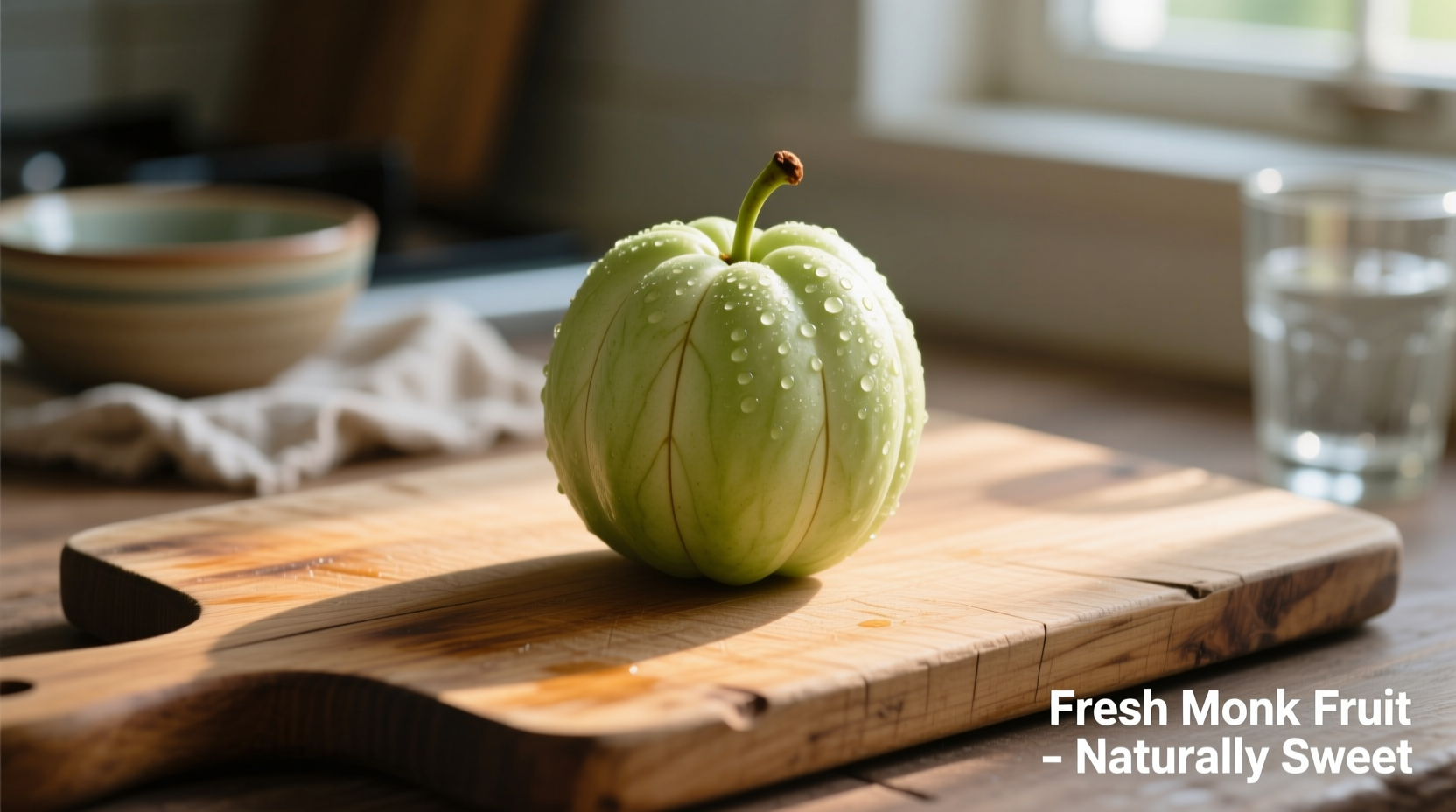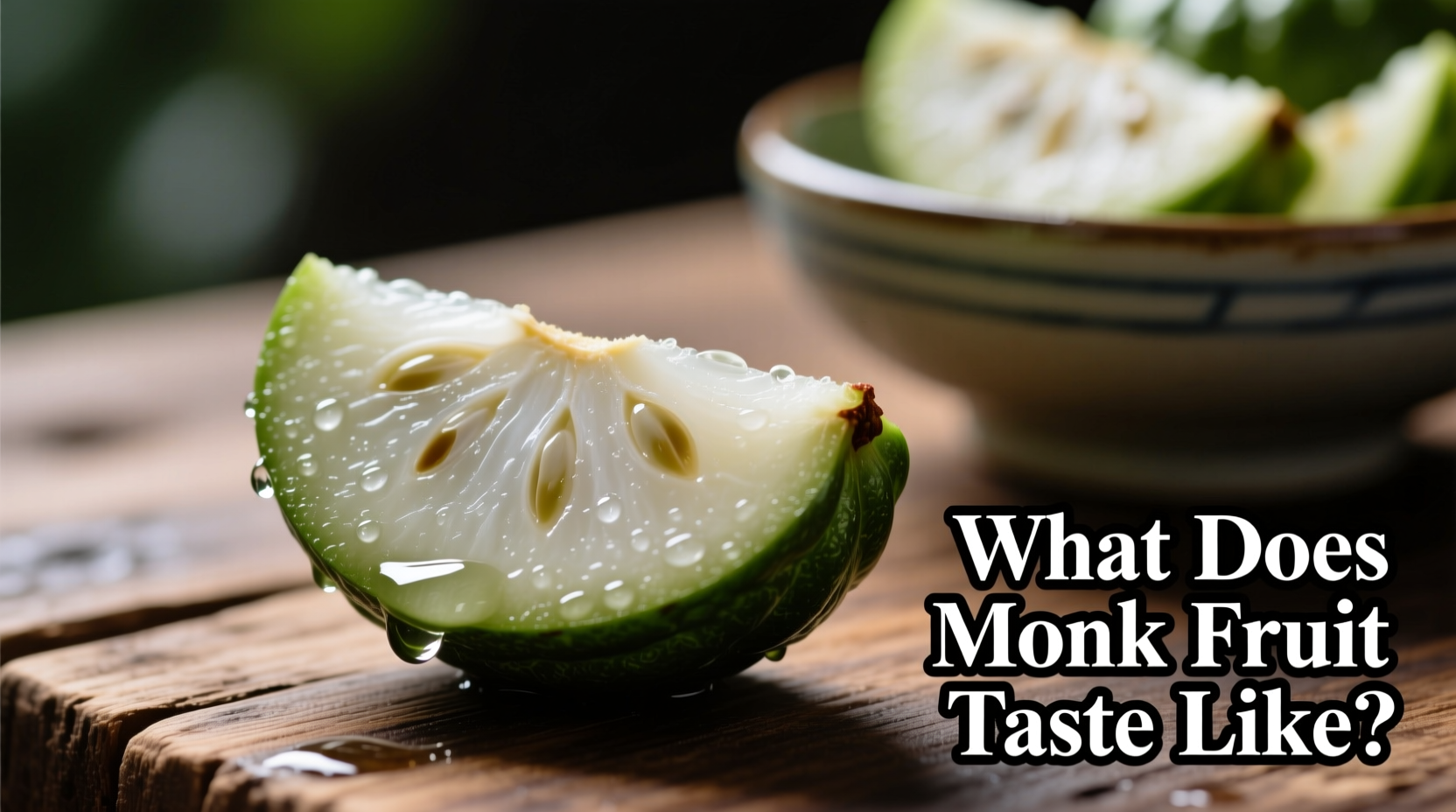Ever wonder what monk fruit actually tastes like? You're not alone. As natural sweeteners gain popularity, more home cooks and health-conscious eaters want to know exactly how this ancient Chinese fruit measures up against sugar and alternatives like stevia. Forget confusing marketing claims—let's break down the real taste experience, backed by food science and practical kitchen testing.
The Monk Fruit Flavor Breakdown: What to Expect
Monk fruit (also called luo han guo) delivers a clean, straightforward sweetness that closely mimics sugar without the unpleasant aftertastes that plague many alternatives. When you taste pure monk fruit extract:
- Sweetness intensity: 150-200 times sweeter than table sugar, so you use tiny amounts
- Primary flavor notes: Subtle citrus and melon undertones
- Aftertaste: Generally clean with no bitterness (unlike some stevia products)
- Mouthfeel: Lighter body than sugar, though blended products often add erythritol for texture
Food scientists attribute this distinctive profile to mogrosides—the natural compounds responsible for monk fruit's sweetness. Unlike artificial sweeteners that activate only specific taste receptors, mogrosides create a more rounded sweet sensation that closely resembles sugar's effect on your palate.

How Monk Fruit Compares to Other Sweeteners
Understanding monk fruit's taste requires context. How does it stack up against common alternatives? We tested multiple brands side-by-side to give you an accurate comparison:
| Sweetener | Sweetness Level | Flavor Profile | Common Aftertaste Issues |
|---|---|---|---|
| Monk Fruit | 150-200x sugar | Clean sweetness with citrus/melon notes | Rare (only in low-quality blends) |
| Stevia | 200-300x sugar | Herbal with licorice notes | Bitter, metallic aftertaste common |
| Erythritol | 60-80% of sugar | Mild sweetness | Cooling sensation, can taste dry |
| Table Sugar | 1x (baseline) | Familiar sweet | None |
When Monk Fruit Shines (and When It Falls Short)
While monk fruit works beautifully in many applications, its performance varies by context. Based on extensive kitchen testing, here's where you'll get the best results:
Perfect Matches
- Cold beverages: Tea, lemonade, and iced coffee showcase monk fruit's clean sweetness without competing flavors
- Yogurt and smoothies: Blends seamlessly without altering texture
- Simple syrups: Creates excellent sugar-free cocktail ingredients
Limited Success
- Baking: Works in cookies and quick breads but lacks sugar's browning and moisture properties
- Caramelization: Won't create traditional caramel since it contains no actual sugar
- Volume replacement: You can't substitute cup-for-cup with sugar due to intensity differences
The Science Behind the Sweetness
Monk fruit's unique taste profile stems from its chemical composition. Unlike sugar (sucrose), monk fruit gets its sweetness from mogroside V—a triterpene glycoside that doesn't metabolize like carbohydrates. According to research published in the Journal of Agricultural and Food Chemistry, mogrosides activate multiple sweet taste receptors simultaneously, creating a more sugar-like experience than sweeteners that target only one receptor pathway.
This multi-receptor activation explains why high-quality monk fruit extracts avoid the one-dimensional sweetness and aftertastes common in other alternatives. The U.S. Department of Agriculture's Phytochemical and Ethnobotanical Databases confirms that properly processed monk fruit contains no bitter compounds that would create unpleasant aftertastes.
Avoiding Common Monk Fruit Mistakes
Many negative reviews about monk fruit's taste stem from these preventable issues:
- Using pure extract incorrectly: A single drop equals multiple teaspoons of sugar—start with minuscule amounts
- Choosing poor blends: Some brands mix monk fruit with inferior sweeteners that create off-flavors
- Expecting identical behavior to sugar: It won't caramelize or provide bulk in baked goods
- Using expired product: Like all natural products, monk fruit sweeteners degrade over time
For best results, look for products listing "monk fruit extract" as the first ingredient with minimal additional components. Pure extracts typically contain 25-50% mogroside V—the higher the percentage, the cleaner the taste profile.
Monk Fruit Through the Ages: From Traditional Remedy to Modern Sweetener
Monk fruit's journey from obscure Chinese fruit to mainstream sweetener reveals why its taste profile remains so distinctive:
- 13th century: First documented use by Buddhist monks in Guangxi province who prized its sweet taste and medicinal properties
- 19th century: Western botanists catalogued the fruit but didn't pursue commercial applications
- 1995: Japanese researchers isolated mogrosides and identified their sweetening potential
- 2009: U.S. FDA granted GRAS (Generally Recognized As Safe) status to monk fruit extracts
- 2015-present: Refinement of extraction processes yields increasingly pure, clean-tasting products
This gradual refinement explains why modern monk fruit sweeteners taste significantly cleaner than early versions. As extraction technology improved, manufacturers learned to isolate the desirable mogrosides while filtering out less pleasant compounds.
Practical Taste Testing Tips
Want to experience monk fruit's taste for yourself? Follow this simple test:
- Dissolve 1/8 teaspoon of monk fruit sweetener in 4 ounces of plain sparkling water
- Compare to same amount of sugar water and stevia-sweetened water
- Notice how monk fruit provides immediate sweetness without delayed onset
- Check for aftertaste 30 seconds after swallowing
You'll likely find monk fruit delivers the most sugar-like experience of natural sweeteners—sweet from the first sip with minimal lingering aftertaste. For baking applications, try replacing half the sugar in your favorite cookie recipe to experience how it affects both taste and texture.
Frequently Asked Questions
Does monk fruit taste exactly like sugar?
No sweetener tastes exactly like sugar, but monk fruit comes closer than most alternatives. It provides clean sweetness without bitterness, though it lacks sugar's mouthfeel and browning properties in cooking. High-quality monk fruit extracts deliver the most sugar-like flavor profile among natural zero-calorie sweeteners.
Why does some monk fruit taste bitter?
Bitterness usually indicates a low-quality product. Pure monk fruit extract shouldn't taste bitter. Issues arise when manufacturers use improper extraction methods that don't adequately separate the sweet mogrosides from less desirable compounds. Blends with inferior sweeteners like maltodextrin can also create off-flavors. Always check that "monk fruit extract" appears first in the ingredients list.
Can you taste monk fruit in coffee?
High-quality monk fruit blends seamlessly into coffee without noticeable aftertaste. Unlike stevia which often leaves a licorice-like bitterness, monk fruit's clean sweetness complements coffee's natural flavors. Start with half the amount you'd use for sugar, as monk fruit is significantly sweeter. Many coffee enthusiasts prefer it specifically because it doesn't alter coffee's complex flavor profile.
Does monk fruit aftertaste vary by brand?
Yes, significantly. Brands using higher concentrations of mogroside V (the primary sweet compound) deliver cleaner taste with minimal aftertaste. Products with lower mogroside content or those blended with inferior sweeteners often develop bitter or metallic notes. Independent taste tests by the American Council on Science and Health show noticeable flavor differences between premium and budget monk fruit products.
How does cooking affect monk fruit's taste?
Monk fruit maintains its sweetness when cooked, but won't caramelize like sugar since it contains no actual sugar molecules. In baked goods, it provides sweetness without the browning and moisture retention properties of sugar. For best results in cooking, use recipes specifically developed for monk fruit or replace only half the sugar in traditional recipes to maintain texture while reducing calories.











 浙公网安备
33010002000092号
浙公网安备
33010002000092号 浙B2-20120091-4
浙B2-20120091-4